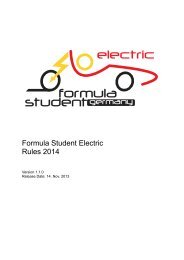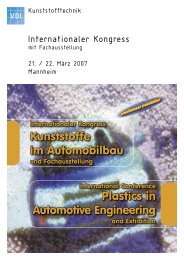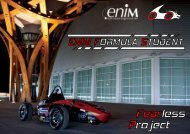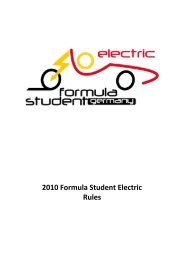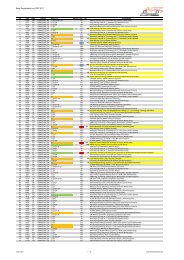FSG RULES 2010 ver1.03 - Formula Student Germany
FSG RULES 2010 ver1.03 - Formula Student Germany
FSG RULES 2010 ver1.03 - Formula Student Germany
You also want an ePaper? Increase the reach of your titles
YUMPU automatically turns print PDFs into web optimized ePapers that Google loves.
<strong>Formula</strong> <strong>Student</strong> <strong>Germany</strong><br />
Rules <strong>2010</strong><br />
5 SEF and IAD Documents<br />
5.1 Structural Equivalency and Structural Equivalency Form<br />
All teams must submit the <strong>FSG</strong> Structural Equivalency Form, supplied in <strong>FSG</strong> Rules<br />
Appendix A-A.<br />
The use of alternative materials or tubing sizes to those specified in <strong>Formula</strong> SAE® <strong>2010</strong><br />
Rule B 3.3.1 “Baseline Steel Material” is allowed, provided they have been judged by a<br />
technical review to have equal or superior properties to those specified in <strong>Formula</strong> SAE®<br />
<strong>2010</strong> Rule B 3.3.1 “Baseline Steel Material”.<br />
Structural equivalency must be demonstrated by providing calculations and/or tests results.<br />
All calculations must compare the alternative material with S235Jr (Material number 1.0037).<br />
Tensile strength and yield stress properties (at a minimum) of the alternative material must be<br />
compared with the same attributes of S235Jr.<br />
All formula symbols and abbreviations, used in the SEF, must be defined.<br />
5.2 Impact Attenuator Data<br />
All teams must submit the <strong>FSG</strong> Impact Attenuator Data Form, supplied in <strong>FSG</strong> Rules<br />
Appendix A-B, along their test results, description of the test setup, the used test equipment<br />
and photo documentation of the IAD before and after the test. The Impact Attenuator Data<br />
must be submitted no later than the specified date.<br />
6 Technical Inspection<br />
6.1 Inspection & Testing Requirement<br />
Tech Inspectors will mark or seal various different approved parts (i.e. air restrictor, tires,<br />
rims etc.). The car can be disqualified from any dynamic event by using, or substituting<br />
unmarked parts. Parts with broken seals are equivalent to being unmarked.<br />
6.2 Car Weighing<br />
All cars will be weighed prior to Engineering Design Judging. All cars are to be weighed in<br />
ready to race condition. The fuel tank must be filled to the fuel level line. All lubricants and<br />
coolants must be in the car. This weight will be the car’s Official Technical Inspection<br />
weight. There will be a penalty if the car weight changes during Dynamic Competition. The<br />
allowable weight tolerance is ± 5.0 kg. In the case of overweight or underweight in<br />
comparison to the Technical Inspection weight, the team will be penalized -20 (twenty) points<br />
for each kg (or portion of a kg) of additional or missing weight. This point penalty will be<br />
deducted from the Engineering Design Event score. (Each 0.1 to 1.0 kg = -20 points)<br />
Example:<br />
If the car is 5.3 kg underweight: 5.3 kg minus the 5.0 kg tolerance = 0.3 kg equals -20 Points<br />
If the car is 7.8 kg overweight: 7.8 kg minus the 5.0 kg tolerance = 2.8 kg equals -60 Points<br />
If the car weight changes due to replacement of broken parts, the car must be presented for<br />
tech inspection and then re-weighed. It is the team's responsibility to have the car re-weighed<br />
before entering a dynamic event after changing parts.<br />
13



